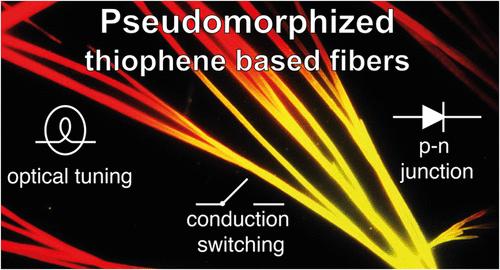纳米结构噻吩基材料的赝晶转变
IF 16
1区 材料科学
Q1 CHEMISTRY, MULTIDISCIPLINARY
引用次数: 0
摘要
这项研究揭示了纳米结构有机材料进行伪晶转化的能力,这是一种在矿物王国中普遍存在的现象,涉及到用新的矿物相替换矿物相,同时保持原有的形状和体积。具体来说,HOF·CH3CN诱导的预成型噻吩基一维纳米结构的后氧化过程保留了它们的宏观/微观形态,同时通过形成新的氧化相显著改变了它们的电光性能。实验证据证明,这种转变是通过界面耦合溶解-沉淀机制进行的,导致多孔氧化壳的生长,其厚度随暴露时间的变化而变化,包裹着原始的光滑核心。微光谱和DFT计算证实,氧化物质比核心材料表现出更强的电子受体特征,促进电荷转移态的形成。这使得(1)纳米结构表面电位的精确调制,允许通过湿化学处理形成具有精确空间分辨率的完全有机异质结;(ii)纳米结构的有效掺杂,导致电导率温度依赖性的强烈变化,并根据施加的偏压在低导和高导状态之间切换。总的来说,这项工作展示了一种具有预先建立的形态和定制的化学物理性质的工程“不可能”复合结构的方法。本文章由计算机程序翻译,如有差异,请以英文原文为准。

Pseudomorphic Transformation in Nanostructured Thiophene-Based Materials
This study reveals the capability of nanostructured organic materials to undergo pseudomorphic transformations, a ubiquitous phenomenon occurring in the mineral kingdom that involves the replacement of a mineral phase with a new one while retaining the original shape and volume. Specifically, it is demonstrated that the postoxidation process induced by HOF·CH3CN on preformed thiophene-based 1D nanostructures preserves their macro/microscopic morphology while remarkably altering their electro-optical properties by forming a new oxygenated phase. Experimental evidence proves that this transformation proceeds via an interface-coupled dissolution–precipitation mechanism, leading to the growth of a porous oxidized shell that varies in thickness with exposure time, enveloping the pristine smooth core. The oxygenated species exhibits stronger electron-acceptor characteristics than the core material, promoting charge transfer state formation, as confirmed by microspectroscopy and DFT calculations. This enables (i) precise modulation of the nanostructure’s surface potential, allowing for the formation of entirely organic heterojunctions with precise spatial resolution via wet chemical processing; (ii) effective doping of the nanostructure, resulting in a strong change of the conductivity temperature dependence and a switch between a low and high conduction state depending on the applied bias. Overall, this work showcases an approach to engineering “impossible” composite architectures with pre-established morphology and tailored chemical-physical properties.
求助全文
通过发布文献求助,成功后即可免费获取论文全文。
去求助
来源期刊

ACS Nano
工程技术-材料科学:综合
CiteScore
26.00
自引率
4.10%
发文量
1627
审稿时长
1.7 months
期刊介绍:
ACS Nano, published monthly, serves as an international forum for comprehensive articles on nanoscience and nanotechnology research at the intersections of chemistry, biology, materials science, physics, and engineering. The journal fosters communication among scientists in these communities, facilitating collaboration, new research opportunities, and advancements through discoveries. ACS Nano covers synthesis, assembly, characterization, theory, and simulation of nanostructures, nanobiotechnology, nanofabrication, methods and tools for nanoscience and nanotechnology, and self- and directed-assembly. Alongside original research articles, it offers thorough reviews, perspectives on cutting-edge research, and discussions envisioning the future of nanoscience and nanotechnology.
 求助内容:
求助内容: 应助结果提醒方式:
应助结果提醒方式:


